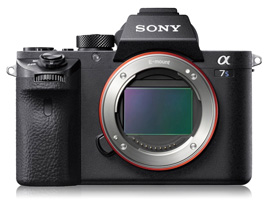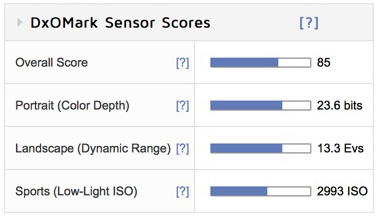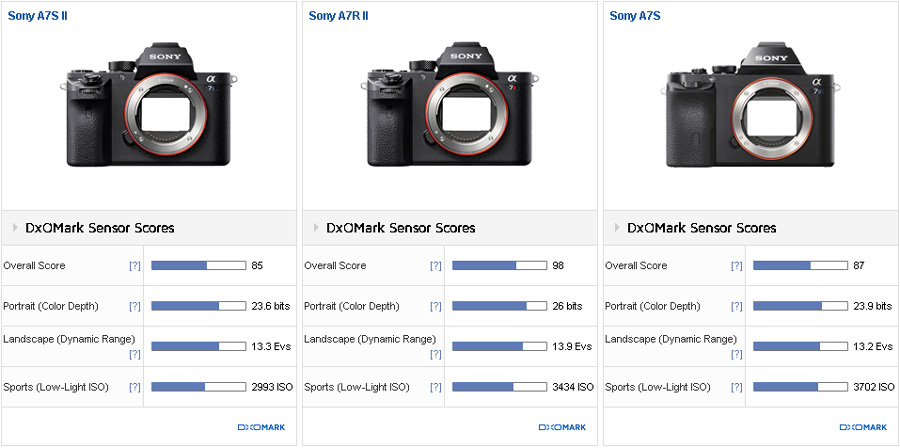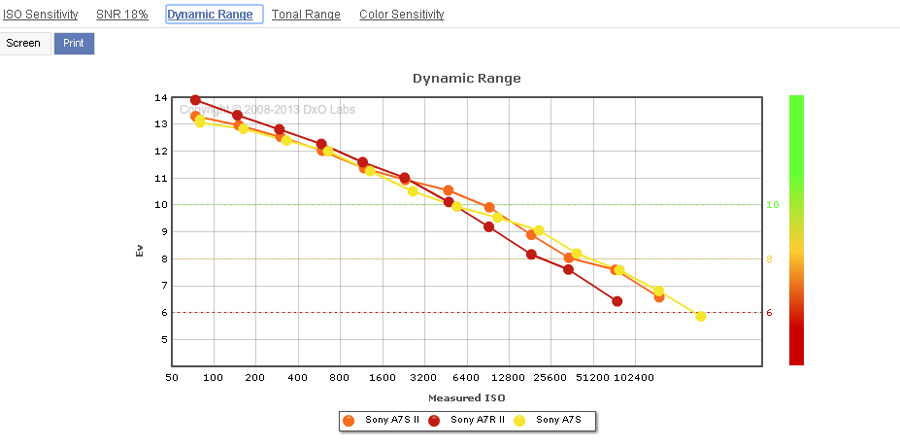Introduction
Specifications and Features
The Sony A7S II is the not-unexpected update of the earlier video-centric 12-Mpix A7S. Like its predecessor, it adopts a full-frame 12.2MP Exmor CMOS sensor, but now boasts 5-axis stabilization and internal UHD 4K recording at 30 fps with full pixel read-out (without pixel-binning). In addition, there’s 1080p recording at up to 120 fps (for slow-motion footage) and all in XAVC S format. Picture Profile settings have been redeveloped, adding S-Gamut3.Cine/S-Log3 and S-Gamut3/S-Log3, which deliver what the company claims (“wide dynamic range and simple color correction”) and complement the camera’s 4K recording capabilities.
The BIONZ X image processor enables increased sensitivity to ISO 409,600, continuous shooting to 5 fps, Fast Intelligent AF with 169 points, and low-light sensitivity to an impressive –4 EV. The A7S II adopts the distinctive industrial design of its predecessor and features a 0.5-inch 2.36m-Dot XGA OLED Tru-Finder EVF and a 3.0-inch 1.28m-dot tilting LCD to the rear.
The new A7S II measures 5.0 x 3.78 x 2.36” / 127 x 96 x 60mm and weighs 22.12 oz / 627g, body only.
- 12.2MPix Exmor CMOS
- BIONZ X image processor
- 5-axis stabilization
- Internal 4K/30p and 1080/120p video
- New S-Gamut3.Cine/S-Log3, S-Gamut3/S-Log3 profiles
- 0.5-inch 2.36m-Dot XGA OLED Tru-Finder EVF
- 3.0-inch 1.28m-dot tilting LCD
- Expanded ISO 409,600 max sensitivity
- 5 fps continuous shooting
- Built-in Wi-Fi connectivity with NFC
Measurements: Excellent low-light score
The new Sony A7s II achieved an DxOMark score of 85 points, with a combination of 23.6 bits color sensitivity, 13.3 EV dynamic range, and 2993 ISO low-light score. In spite of the physically large-size pixels (or “sensels,” if you prefer), the full-frame sensor in the A7s II ranks a little behind others in the lineup. Both the 24-Mpix A7 II and 42-Mpix A7R II models, for example, achieved higher results for color sensitivity and dynamic range. As you might expect, though, one area where the A7s II excels is low-light capability. It is here that it outperforms most of the A7 models, with the exception of the A7R II and, somewhat surprisingly, its predecessor, the A7s. However, the advantage is slight. Overall, the scores are very good, particularly with regard to low-light sensor dynamics, though inevitably expectations are exceedingly high for a sensor like this.
Comparison 1: Sony A7S II versus Sony A7S versus Sony A7R II: Impressive high ISO DR
Although the DxOMark score is slightly below the earlier A7S, the difference is pretty much negligible. The A7S II is slightly behind in color sensitivity, equating to just 0.3 bits color depth, which isn’t really perceivable in use. However, the maximum score of 23.6 bits at base through 22.1 bits at ISO400 is considered excellent. Compared to the A7R II, though, color sensitivity is over 2 bits lower at base, which is noticeable, and impressively, that model maintains a significant improvement through ISO6400, at 18.3 bits.
With a difference of around –0.3 EV, the new model is also slightly behind its predecessor in high ISO capabilities (the low-light ISO use case determines the maximal ISO sensitivity required to achieve our benchmark 30 dB SNR). It is also behind the A7R II, but the difference of around –0.15 EV is negligible in most cases.
As for dynamic range, the new model is practically identical to its predecessor — and not just at base, but more or less throughout the ISO range. However there has been an improvement or refinement perhaps, between ISO3200 and 12800 (albeit at the expense of ISO25600 and 51200). Against the A7R II, though, the A7S isn’t quite so tolerant at low ISOs, but it’s not behind by much and as you might expect, dynamic range in the A7S II overtakes the A7R II from ISO3200 onwards.
Comparison 2: Sony A7S II versus Nikon Df versus Nikon D810
The A7S II occupies a somewhat unique position in the marketplace. We’ve compared the A7S II with the Nikon Df, mindful of the fact that the Nikon has no video capability but outperforms the Nikon D4s in low-light, even though it achieves the same overall DxOMark score as its sibling. And we’ve also elected to compare the A7S II with the Nikon D810. Both models have superior color sensitivity, with the Df offering a one-bit improvement at base and mostly throughout the range. The D810 has a two-bit advantage at base, dropping to 21.8 bits at ISO800, but it can’t maintain the advantage from ISO1600 onwards, where it matches the Sony.
The Sony starts to reveal some advantages when it comes to dynamic range. It can’t compete with the D810 at low ISOs, but it matches the Df and catches up with the D810 from ISO400, after which at ISO3200, the Sony takes the lead. The Nikon Df, however, used to stand out for its low-light, high-ISO capabilities, but now it only matches the A7R II (see above), and is only fractionally above the A7S II. The D810 is another capable camera that offers near-identical performance, which goes to show just how good a camera it is.
Conclusion
Like its predecessor, the sensor in A7S II has impressive low-light performance — in fact, very impressive high ISO dynamic range, particularly between ISO3200 and 12800. But it comes at the expense of pixel count and the dynamics are not much of an improvement over the A7S, which we suspect will continue to limit the appeal to still photographers. As a camera intended primarily for videographers, however, that may not be much of an issue. Anyone that has invested in the A7 or A7R variants looking for a complementary video-centric model need look no further than the A7S II.














DXOMARK encourages its readers to share comments on the articles. To read or post comments, Disqus cookies are required. Change your Cookies Preferences and read more about our Comment Policy.